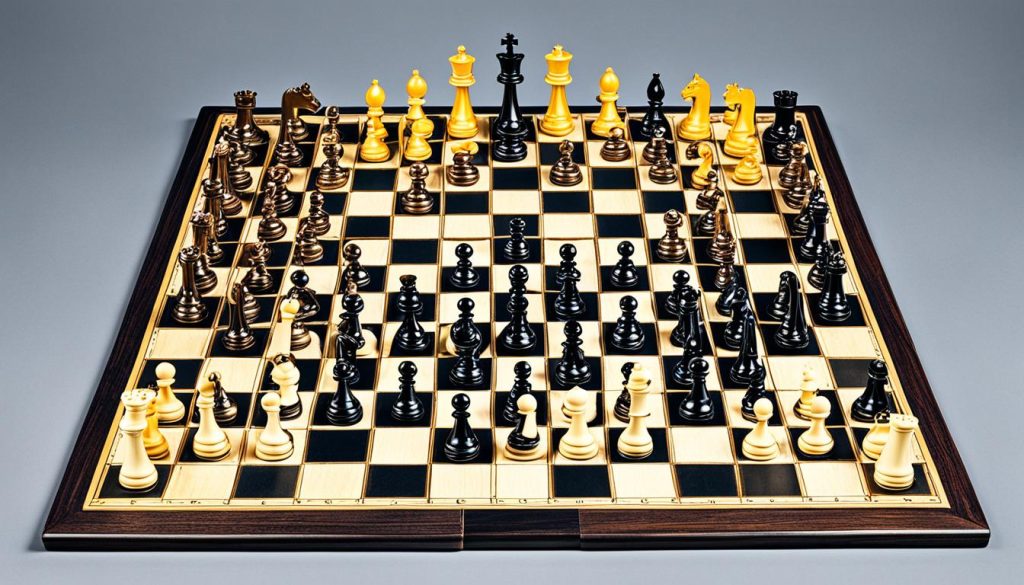The captivating prospect of winning chess games in just three moves has long intrigued chess enthusiasts and novices alike. This article delves into the secrets behind swift checkmates, unveiling renowned tactics like the “Fool’s Mate” and other quickfire strategies to defeat opponents. Readers will discover methods to achieve checkmate in three moves, both while capturing and without capturing pieces. Additionally, the article provides expert tips for mastering these three-move checkmates, recognising appropriate opponents, maintaining balanced piece development, and adapting to defensive responses.
Beyond the allure of swift checkmates, the article also explores expanding one’s chess repertoire, delving into the study of various openings, strategies, middlegame tactics, and endgame principles. By the end of this comprehensive guide, readers will be empowered to claim victory on the chessboard in the blink of an eye, whether through the mastery of three-move checkmates or a well-rounded approach to the game.
How to Win at Chess in 3 Moves?
The article begins by exploring the captivating possibility of winning chess games in just three moves. It delves into the mesmerising allure of swift checkmates, unveiling the secrets behind these opening chess moves and chess tactics that have long intrigued chess enthusiasts and novices alike.
Unveiling the Secrets of Swift Checkmates
Readers will discover renowned techniques like the “Fool’s Mate,” a devastating chess opening that can lead to an embarrassing checkmate as early as the second move of the game. The article also examines other renowned chess strategies and checkmate patterns that can result in a three-move checkmate, analysing their nuances and potential pitfalls.
Mastering Renowned Tactics Like the “Fool’s Mate”
The article delves deeper into blitz chess and the mastery of tactics such as the infamous “Fool’s Mate.” This devastating chess gambit and chess trap can catch unsuspecting opponents off guard, leading to a swift and humiliating defeat in a mere three moves. Readers will learn the intricate details of this and other potent chess openings that can deliver a rapid checkmate.

Methods to Achieve Checkmate in Three Moves
As the article delves deeper, it explores the specific methods and sequences of moves that can lead to a checkmate in just three moves. Two distinct approaches are examined: achieving checkmate while capturing pieces, and doing so without capturing any opponent’s pieces.
Getting Checkmate in Three Moves While Capturing
In the first method, readers will learn about the King’s Gambit Accepted, where White sacrifices a pawn to lure the opponent into an aggressive position, ultimately leading to a decisive checkmate. This renowned chess gambit has captivated players for centuries, offering a swift path to victory if executed correctly.
The article also examines how to bring the queen to a dominant position on the h5 square, threatening the weak f7 pawn and creating a powerful mating attack. This checkmate pattern can catch unsuspecting opponents off guard, leading to a decisive three-move win.

Executing the King’s Gambit Accepted
The King’s Gambit Accepted is a classic chess opening where White sacrifices a pawn to initiate an aggressive attack. The sequence of moves typically goes: 1. e4 e5 2. f4 exf4 3. Nf3 g5 4. Bc4 g4 5. O-O gxf3 6. Qxf3, leading to a powerful mating attack on the vulnerable black king.
By mastering the nuances of this chess gambit, players can catch their opponents off guard and secure a swift victory in just three moves.
Bringing the Queen to a Dominant Position
Another method to achieve checkmate in three moves is by bringing the queen to a dominant position on the h5 square. This strategic manoeuvre threatens the weak f7 pawn, creating a potent mating attack. The typical sequence could be: 1. e4 e5 2. Nf3 Nc6 3. Bc4 Nf6 4. Qh5, leaving the black king exposed and vulnerable to a decisive checkmate.
By understanding these checkmate patterns and mastering the execution of these chess openings, players can surprise their opponents and claim victory in a matter of just three moves.
Expert Tips for Mastering Three-Move Checkmates
Mastering the art of winning chess in just three moves requires more than just memorizing a few tactical patterns. The article delves into expert tips that can help players hone this captivating skill set and apply it effectively against their opponents.
Recognising Appropriate Opponents
One of the key factors in successfully executing three-move checkmates is recognising suitable opponents. These lightning-fast tactics tend to be most effective against less experienced players or those unfamiliar with the specific patterns and traps involved. By identifying opponents who may be vulnerable to such aggressive opening strategies, players can increase their chances of claiming a quick victory.
Maintaining Balanced Piece Development
While the allure of a swift checkmate can be tempting, it is crucial to maintain balanced piece development throughout the game. Players must ensure that their pursuit of a three-move win does not come at the expense of neglecting the overall control of the board. Maintaining a harmonious coordination of their pieces, even in the opening, can help players avoid potential pitfalls and secure a more well-rounded advantage.
Adapting to Defensive Responses
As players become more adept at chess strategies and tactics, they may encounter opponents who are better equipped to defend against the three-move checkmate attempts. In such situations, it is essential to demonstrate flexibility and a willingness to adapt. Players should be prepared to adjust their approach, exploring alternative tactics and opening lines, in order to outmanoeuvre stronger opponents and achieve victory through other means.

Expanding Your Chess Repertoire Beyond Swift Checkmates
While the allure of winning chess games in just three moves is undeniable, it is crucial to understand that such swift checkmates may not always work against experienced opponents. To truly excel in the game of chess, players must expand their repertoire beyond these specific tactics and strive to develop a well-rounded understanding of the game’s intricacies.
Studying Various Openings and Strategies
Delving into a diverse array of chess openings and chess strategies can significantly broaden one’s chess knowledge and versatility. From the time-honoured chess openings like the Sicilian Defence or the Queen’s Gambit, to more modern and dynamic approaches, exploring a range of openings can equip players with a deeper appreciation for the game’s nuances and the countless possibilities that arise from the initial moves.
Honing Middlegame Tactics and Endgame Principles
Beyond the opening phase, mastering chess tactics and chess strategy in the middlegame is paramount. Studying common chess tactics such as forks, pins, and skewers, as well as understanding the principles of chess endgames, can provide players with the tools to navigate the complex and ever-changing dynamics of the middle and late stages of the game. By developing a comprehensive understanding of these critical aspects, players can enhance their overall chess prowess and increase their chances of success, even against stronger opponents.
By diversifying their chess knowledge and skills, players will be better equipped to navigate the complexities of the game and become formidable opponents, capable of adapting to a wide range of situations on the chessboard.

Conclusion
In conclusion, the article emphasises that while mastering the art of winning chess in three moves can be an exciting and deceptive strategy, it is crucial to remember that such tactics may not always work against experienced players. To truly excel in chess, one must expand their repertoire, understanding various openings, and honing their strategic skills.
While learning quick checkmate techniques can be thrilling, a well-rounded approach is essential for long-term success on the chessboard. The article encourages readers to continue exploring the depths of chess, combining the insights gained from three-move checkmates with a broader understanding of the game’s principles and strategies.
Ultimately, the article underscores the importance of diversifying one’s chess knowledge and skills, rather than solely relying on swift checkmate maneuvers. By adopting a more comprehensive approach, readers will be better equipped to navigate the complexities of the game and emerge as formidable players, capable of triumphing in a variety of chess scenarios.
FAQ
What is a three-move checkmate called?
A checkmate achieved in just three moves is often referred to as the Fool’s Mate, a devastating opening that can lead to an embarrassing quick victory.
What are the best first three moves in chess to achieve a checkmate?
Some of the most well-known three-move checkmate sequences include the King’s Gambit Accepted, where White sacrifices a pawn to lure the opponent into an aggressive position, and the Queen’s Pawn Opening, where White advances the d-pawn to create space and prepare for an attack on the kingside.
How do you win chess in 3 moves with black?
To achieve a three-move checkmate with the black pieces, one effective method is to capitalise on weaknesses in the opponent’s position by employing the Queen’s aggressive manoeuvre to the h5 square, directly threatening the vulnerable f7 pawn and setting up a potential decisive checkmate.






